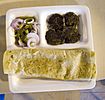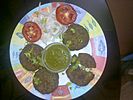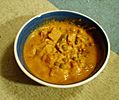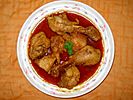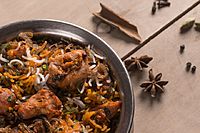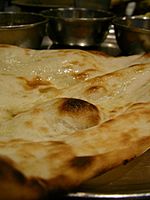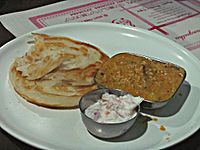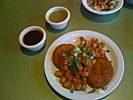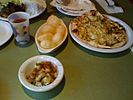Awadhi cuisine facts for kids
Awadhi cuisine is a special style of cooking from the Awadh region in Northern India. It's a mix of flavors from places like Central Asia, the Middle East, and other parts of Northern India. You'll find both vegetarian and non-vegetarian dishes.
Awadhi food has been greatly influenced by the Mughal Empire's cooking methods. This is why it shares similarities with food from Kashmir, Punjab, and Hyderabad. The city of Lucknow is especially famous for its "Nawabi" (royal) foods.
Contents
The Start of Awadhi Cooking
Long ago, the expert chefs (called bawarchis) and gourmet cooks (called rakabdars) of Awadh created a unique way of cooking. They invented the dum style of cooking. This means cooking food slowly in a sealed pot over a very low flame. This method is now a signature of Lucknow's cuisine.
Their meals were grand, featuring dishes like kebabs, kormas, biryanis, and special breads. The richness of Awadhi food comes from its variety and the ingredients used. These include mutton, paneer (Indian cheese), and rich spices like cardamom and saffron.
Delicious Kebabs
Kebabs are a very important part of Awadhi cuisine. Lucknow is especially proud of its many types of kebabs. Some popular ones are Kakori Kebabs, Galawat ke Kebabs, Shami Kebabs, and Seekh Kebabs.
Awadhi kebabs are different from those made in Punjab. Awadhi kebabs are often grilled on a special stove called a chula or cooked in a pan. Punjabi kebabs, however, are usually cooked in a tandoor (a clay oven). Because of this, Awadhi kebabs are sometimes called "chula" kebabs.
Popular Kebab Types
The Seekh kebab is a classic dish in Awadhi meals. It was brought by the Mughals. Originally, it was made from beef mince (ground meat) shaped on skewers and cooked over charcoal. Today, lamb mince is often used because it's very soft.
Tunde ke Kabab is very famous in Lucknow. It was named after a chef who had only one arm. The special thing about Tunde kabab is its secret spice mix (masala). This mix is prepared by the women of the family and is said to contain 160 different spices!
Kakori kabab is considered very special. It was first made in a place called Kakori, near a holy shrine. It uses tender meat from lamb legs, mixed with khoya (a milk product) and spices.
Shami kebab is made from minced meat, usually with chopped onion, coriander, and green chilies. These kebabs are round patties. They are often filled with a spicy mix and tangy raw green mango. The best time to eat them is in May when mangoes are young. If mangoes aren't in season, other tart fruits can be used.
A special type of kebab, the Galawat kabab, is made only from minced meat and spices. It doesn't use any other ingredients to bind it together.
The Pasanda kebab is an unusual dish. It's made from thin slices of lamb that are marinated and then quickly cooked on a griddle.
Boti kebab uses lamb marinated in yogurt. It's then cooked on skewers in a tandoor oven.
You can also find Vegetarian kebabs in Awadhi cuisine. These include Dalcha Kebab, Kathal ke Kebab, and Rajma Galoti Kebab (made from kidney beans).
Here is a list of some popular kebabs:
- Kakori kebabs
- Kebabs of Galawat
- Shami kebabs
- Boti kebabs
- Patili-ke kebabs
- Ghutwa kebabs
- Seekh kebabs
Cooking Methods
Awadhi cuisine has its own special cooking methods. While it's similar to Mughlai food, Awadhi dishes use fewer spices. This makes the flavors more subtle. One famous technique is "Dum Dena," which is the slow cooking method mentioned earlier.
Delicious Curries
Korma is an Indian cooking method where meat is slowly cooked in rich, spiced sauces. These sauces are often made creamy with ground nuts, cream, and butter. Kormas are rich but usually mild, with little or no chili. There are both vegetarian kormas, like navratan korma, and non-vegetarian ones, like chicken or lamb korma. Murgh Awadhi Korma is a classic dish from Lucknow.
Rice Dishes
Biryani is very popular in Awadhi cooking. To make it, pulao is first prepared by cooking basmati rice in ghee (clarified butter) with fragrant spices. Then, layers of this rice are combined with a meat curry or marinade. The pot is sealed and cooked over low heat until everything is perfectly done.
Tasty Breads
Wheat is a main food in this region, so breads are very important. Most breads are flatbreads cooked in a pan. There are many types of roti (bread), made in different ways. These include rumaali roti, tandoori roti, naan (baked in a tandoor), kulcha, and paratha.
Breads made from other grains have names that describe them. For example, Makai ki roti is corn flour bread, and chawal-ki-Roti is rice flour bread.
- Chapati is a very popular flatbread eaten for any meal.
- Puri are small breads that are deep-fried until they puff up.
- Paratha is a flaky, layered bread that is lightly fried. It can be stuffed with vegetables, cheese, or minced meat.
- Rumali Roti is a very thin bread cooked on a curved metal pan. The word rumaali means handkerchief, because it's so thin.
- Tandoori Roti is a thicker bread baked in a tandoor oven.
- Naan is a soft, thick bread often baked in a pan or tandoor.
- Sheermaal is a sweet, baked bread made with flour, milk, sugar, and saffron.
- Baqarkhani is similar to sheermaal but cooked on a griddle instead of baked.
Sweet Desserts
Halwas are common desserts, especially in winter. There are many kinds, made from different grains like gram flour, wheat, nuts, and even eggs. A special type, halwa sohan, comes in four varieties.
Fun Chaat Dishes
Chaat dishes started in Uttar Pradesh and are now popular street foods all over South Asia. Chaat dishes are usually made with fried dough and many other ingredients. A classic chaat mixes potato, chickpeas, spices, chili, and different sauces. Other popular types include Aloo tikkis (potato patties), dahi puri, and golgappa.
Common ingredients in chaat include dahi (yogurt), chopped onions, coriander, and crispy noodles called sev. A special spice mix called chaat masala is also used. This mix often has dried mango powder, cumin, and rock salt. Chaat is usually served on a small plate or a banana leaf.
The Chefs of Awadh
Many chefs used to work for the rulers (nawabs) of Lucknow. Each chef had their own secret recipes to impress the nawab. They kept these recipes very private, often not even sharing them with their own families. Because of this, many unique dishes were lost when the chefs passed away.
Chefs were often given special honors and titles for their amazing cooking. Some famous titles were Bawarchis (chefs) and Daroga-e-Bawarchikhana (Head of the kitchen).
Cooking competitions were held for chefs to show off their skills. The nawab would reward the best dish. This encouraged chefs to create the most amazing and exotic foods. This is how many special dishes and cooking styles, like galawat kebabs and dum pukht, came to be. There's a story that one chef was paid a huge salary just to make a single type of lentil dish!
Gallery
Awadhi dishes
-
Chicken curry with Chapati.
-
Aloo tikki, chutneys, and dahi.
-
Naan a staple bread of Awadh.
-
Kulcha with chhole.
-
Mint salted lassi.
Recipes
Here is a list of some Awadhi recipes:
- Almond Kulfi
- Almond Seera
- Badam Halwa
- Boondi Raita
- Carrot Halwa
- Chicken Korma
- Dahi Gosht
- Fish Kebab
- Galouti Kebab
- Green Peas Paratha
- Gujia
- Gulab Jamun
- Gulkand Peda
- Imarti
- Indian Keema
- Jalebi
- Kachori
- Kaddu Ki Kheer
- Kanji Ke Vade
- Kathi Kebab
- Kele Ki Sabzi
- Khaja
- Kofta Curry
- Kurmura Ladoo
- Kuttu Paratha
- Lachcha Paratha
- Lamb kebab
- Malai Kofta
- Mango Burfi
- Methi Parathas
- Moong Dal Halwa
- Motichoor Ladoo
- Murgh Musallam
- Mushroom Biryani
- Mutton Kabab
- Naan
- Nargisi Kofta
- Navratan Korma
- Navratan Pulao
- Nawabi Curry
- Palak Paneer
- Paneer Korma
- Paneer Stuffed Tomatoes
- Paneer Tikka
- Papri
- Peas Pulao
- Phirni
- Rabdi
- Samosa
- Shahi Paneer
- Shami Kabab
- Tahari
- Thandai
- Til Papdi
- Vegetable Biryani
- Vegetable Pulav
- Yakhni Pulav
- Zafrani Kheer
- Zamin Doz Machhli
- Patili-ke Kebabs
- Ghutwa Kebabs
- Vegetable shami kabab
- Malpoa
- Rabadi
- Dahi balla
Images for kids
See also
 In Spanish: Gastronomía awadhi para niños
In Spanish: Gastronomía awadhi para niños


